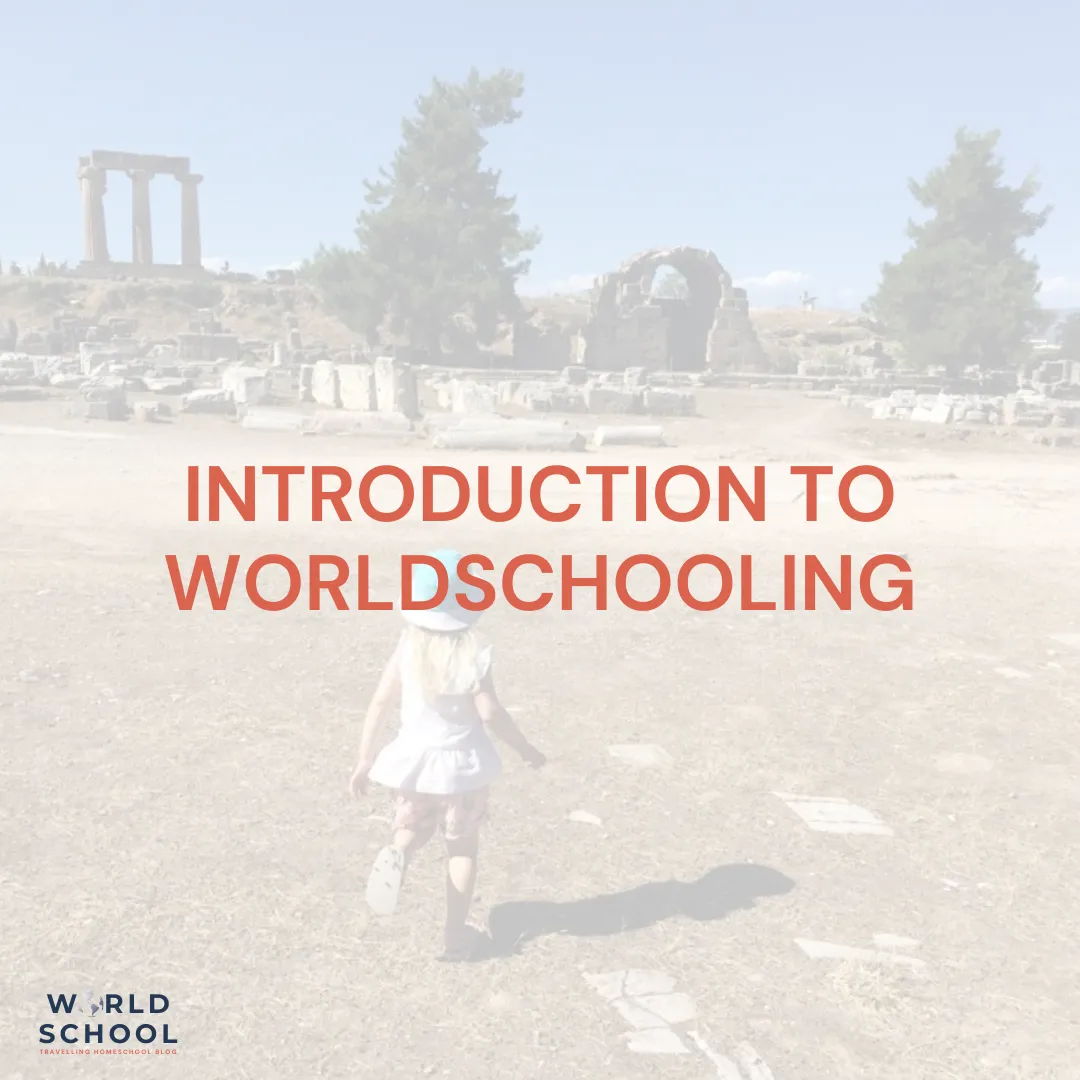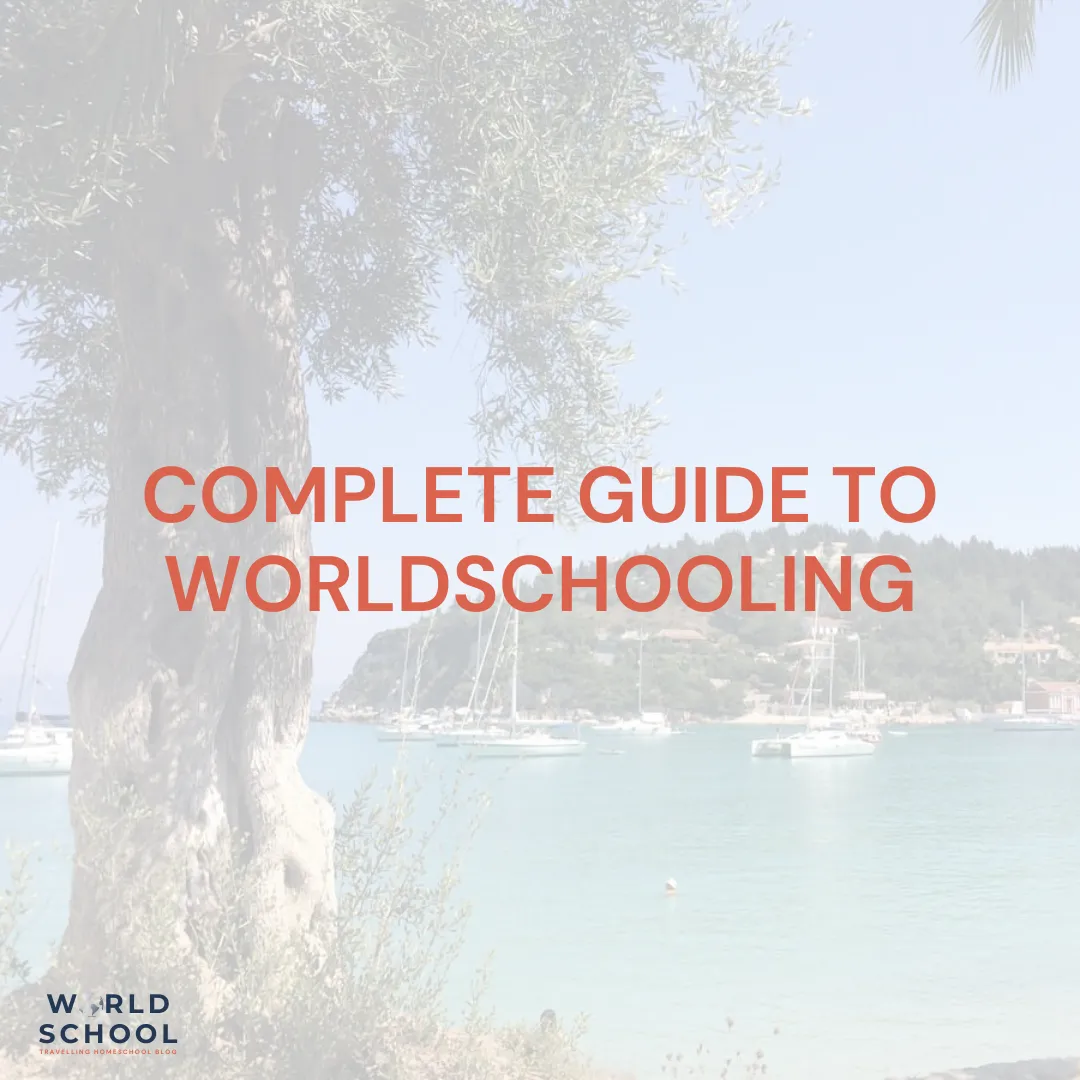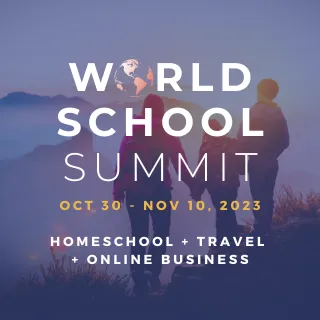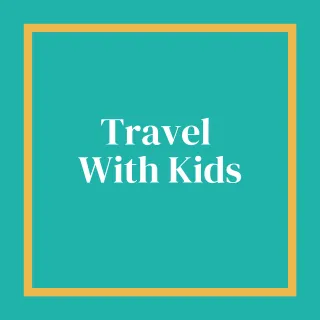Homeschool + Travel + Business
LIVE A LIFE YOU LOVE
OVER ON THE BLOG
HOMESCHOOLING / WORLDSCHOOLING BLOG
RECENT POSTS
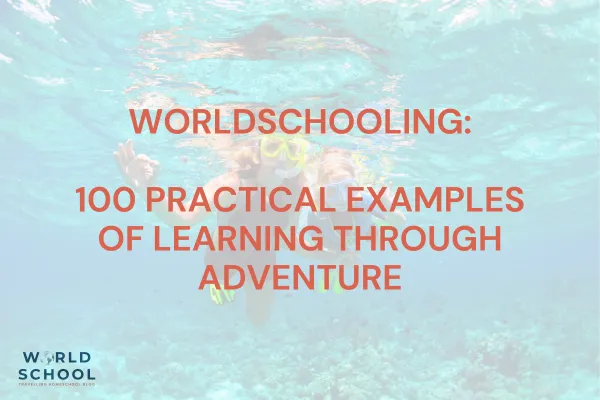
Worldschooling: 100 Practical Examples of Learning Through Adventure
If you’re itching to break free from the conventional classroom and dive headfirst into a world of hands-on education, worldschooling is the ultimate ticket.
We've compiled a whopping 100 practical examples to inspire your own journey of learning through adventure. From ancient history to modern science, culture to language, get ready to discover how the world becomes your classroom.
History and Culture
1. Walking through the ruins of Pompeii to understand ancient Roman life.
2. Visiting the Great Wall of China to grasp the enormity of historical feats.
3. Exploring Machu Picchu to connect with the Incan civilization.
4. Attending Diwali celebrations in India to immerse in cultural festivals.
5. Discovering Native American history in the Mesa Verde National Park.
6. Learning about World War II by visiting Normandy's D-Day beaches.
7. Exploring the Pyramids of Giza to witness the marvels of ancient Egypt.
8. Studying Renaissance art in Florence's museums and galleries.
9. Exploring colonial history in Boston's Freedom Trail.
10. Diving into Greece's mythology and philosophy at ancient sites.
Language and Communication
11. Learning Spanish through a homestay in Ecuador.
12. Witnessing non-verbal communication like bowing in Asian countries like Japan.
13. Practising French while exploring Parisian markets and cafés.
14. Studying Mandarin in China's language schools.
15. Learning Italian foods while ordering authentic pasta in Rome.
16. Engaging with street vendors in Thailand to enhance your Thai skills.
17. Decoding Arabic in the markets of Morocco.
18. Using sign language to communicate with Deaf communities worldwide.
19. Participating in cultural exchange programs to learn languages naturally.
20. Attending language meetups in new countries to practise conversations.
Science and Nature
21. Snorkelling in the Great Barrier Reef to discover the delicate balance in marine biology.
22. Studying geology while hiking in the Grand Canyon.
23. Learning about ecosystems through rainforest exploration in Costa Rica.
24. Discovering multi-hemisphere astronomy at observatories around the world.
25. Studying botany by exploring diverse plant species in specialist botanical gardens.
26. Investigating palaeontology through fossil hunting expeditions in Calvert Cliffs in Maryland, USA.
27. Participating in wildlife conservation projects to learn about ecology in Zimbabwe.
28. Learning about renewable energy by visiting solar and wind farms in Australia.
29. Studying environmental sustainability through eco-tours and workshops in the Caribbean.
30. Engaging in hands-on experiments at science museums worldwide.
Culinary Arts and Food Culture
31. Taking cooking classes in Vietnam to master authentic Pho.
32. Exploring spice markets in India to learn about complex and diverse recipes.
33. Learning sushi-making techniques from the masters in Japan.
34. Participating in orchard tours to understand horticulture around the world.
35. Discovering the art of tea ceremonies in China.
36. Experimenting with regional ingredients to create fusion dishes.
37. Visiting local farms to learn about sustainable agriculture.
38. Studying coffee production in countries like Colombia and Ethiopia.
39. Learning to make traditional pastries in France.
40. Engaging with local chefs to understand the unique cultural significance of food.
Art and Creativity
41. Learning traditional dance forms in countries like India and Brazil.
42. Participating in pottery workshops to explore artistic expression in Greece.
43. Exploring street art in cities like Berlin, Melbourne, and Buenos Aires.
44. Attending music festivals to discover diverse musical genres.
45. Taking photography tours to capture the essence of new places.
46. Learning traditional crafts like weaving, batik, and pottery.
47. Exploring art museums to study different artistic movements through time in New York.
48. Participating in theatre workshops to experience local drama.
49. Engaging in poetry slams and storytelling events worldwide.
50. Sketching by the Seine in Paris to imitate the work of van Gogh.
Geography and Exploration
51. Navigating through the Amazon rainforest to understand its biodiversity.
52. Planning air and road travel between locations, and mapping your journey.
53. Sailing across oceans to learn navigation and seamanship.
54. Studying different biomes by visiting ecosystems like savannas and tundras.
55. Travelling through the Seven Wonders of the World for geography lessons.
56. Investigating unique landforms in national parks, like the Grand Tetons in the USA.
57. Studying the impact of urbanisation by comparing megacities like Tokyo and Mumbai.
58. Learning about plate tectonics and earthquakes in regions like the Pacific Ring of Fire.
59. Exploring volcanic landscapes and calderas in places like Yellowstone National Park.
60. Observing the role of water bodies in shaping landscapes, like the Nile Delta in Egypt.
Mathematics : Real World Applications
61. Budgeting for expenses, currency conversion, and managing travel costs.
62. Marketplace maths involves counting, adding, subtracting and conversion.
63. Explore geometry with famous buildings, discussing shapes, symmetry, and design.
64. Cooking using different metric systems, converting units, and understanding measurement.
65. Calculate distances between destinations on a map, incorporating concepts of scale, distance measurement, and navigation.
66. Time differences provide practice adding and subtracting hours, and teach time zones.
67. Collect data on aspects like weather patterns, local populations, or language usage, and introduce concepts of graphs, averages, and data interpretation.
68. Convert currencies for everyday purchases, honing multiplication and division skills.
69. Study patterns in traditional art, like Islamic tiles or African textiles, to explore concepts of tessellation and repetition.
70. Use maps and GPS devices for navigation, concepts of angles, coordinates, and distance.
Architecture and Engineering
71. Exploring ancient temples in Cambodia to understand architectural marvels.
72. Studying Gothic architecture in cathedrals across Europe.
73. Learning about sustainable building techniques in eco-friendly communities.
74. Investigating engineering feats like bridges, dams, and skyscrapers.
75. Exploring ancient aqueducts and irrigation systems for engineering insights.
76. Studying indigenous architecture in different parts of the world.
77. Analysing city maps for urban planning to understand city development.
78. Exploring staircases and turrets of castles and fortresses around the world.
79. Engaging with local craftsmen to learn about traditional construction.
80. Sketching modern architecture like the Louvre to explore innovative design.
Health and Well-being Exploration
81. Visit regions where traditional healing methods like Ayurveda, Traditional Chinese Medicine, and herbal remedies are prevalent.
82. Explore the nutritional values of local cuisines and ingredients, including traditional diets in places like Japan, the Mediterranean, or Blue Zones known for longevity.
83. Visit local farms and markets to understand where food comes from, how it's grown, and the importance of sustainable agriculture for health and the environment.
84. Study yoga or mindfulness techniques in their cultural origins, like India or Thailand, and practise these for physical and mental well-being.
85. Move your body! Participate in local physical activities, such as martial arts in Asia, hiking in the Andes, or surfing in Australia.
86. Investigate environmental health concerns in various regions, such as air quality in urban areas, water pollution in rivers, or deforestation in rainforests, and their impact on health.
87. Learn about public health initiatives and community healthcare systems in different countries, exploring topics like vaccination programs or disease prevention efforts.
88. Attend wellness retreats and workshops, focusing on holistic health practices.
89. Examine healthcare accessibility by visiting healthcare facilities in different regions and discussing the availability of medical services with local experts.
90. Get involved in healthcare volunteering opportunities, such as assisting in medical clinics or working with healthcare NGOs to understand global health challenges.
Music and Performing Arts
91. Taking dance classes like Salsa to learn traditional dance forms around the world.
92. Learning to play indigenous musical instruments in different cultures.
93. Participating in theatre productions to understand local storytelling.
94. Exploring the history of classical music in cities like Vienna and Prague.
95. Attending music festivals in Europe to experience diverse genres and performances.
96. Engaging with local musicians to learn about their music traditions.
97. Opera and theatre workshops in famous venues worldwide.
98. Discovering the evolution of pop music by visiting music museums in the USA.
99. Learning about cultural significance through traditional songs and chants throughout Asia.
100. Participating in music workshops and jam sessions in various countries.
And there you have it—100 wonderful examples of worldschooling. And there’s thousands more possibilities! Learning opportunities are literally endless.
See what sparks your interest and fan the fire - and go for it!
HAPPY WORLDSCHOOLING!
TRAVEL WITH KIDS BLOG
RECENT POSTS

Worldschooling: 100 Practical Examples of Learning Through Adventure
If you’re itching to break free from the conventional classroom and dive headfirst into a world of hands-on education, worldschooling is the ultimate ticket.
We've compiled a whopping 100 practical examples to inspire your own journey of learning through adventure. From ancient history to modern science, culture to language, get ready to discover how the world becomes your classroom.
History and Culture
1. Walking through the ruins of Pompeii to understand ancient Roman life.
2. Visiting the Great Wall of China to grasp the enormity of historical feats.
3. Exploring Machu Picchu to connect with the Incan civilization.
4. Attending Diwali celebrations in India to immerse in cultural festivals.
5. Discovering Native American history in the Mesa Verde National Park.
6. Learning about World War II by visiting Normandy's D-Day beaches.
7. Exploring the Pyramids of Giza to witness the marvels of ancient Egypt.
8. Studying Renaissance art in Florence's museums and galleries.
9. Exploring colonial history in Boston's Freedom Trail.
10. Diving into Greece's mythology and philosophy at ancient sites.
Language and Communication
11. Learning Spanish through a homestay in Ecuador.
12. Witnessing non-verbal communication like bowing in Asian countries like Japan.
13. Practising French while exploring Parisian markets and cafés.
14. Studying Mandarin in China's language schools.
15. Learning Italian foods while ordering authentic pasta in Rome.
16. Engaging with street vendors in Thailand to enhance your Thai skills.
17. Decoding Arabic in the markets of Morocco.
18. Using sign language to communicate with Deaf communities worldwide.
19. Participating in cultural exchange programs to learn languages naturally.
20. Attending language meetups in new countries to practise conversations.
Science and Nature
21. Snorkelling in the Great Barrier Reef to discover the delicate balance in marine biology.
22. Studying geology while hiking in the Grand Canyon.
23. Learning about ecosystems through rainforest exploration in Costa Rica.
24. Discovering multi-hemisphere astronomy at observatories around the world.
25. Studying botany by exploring diverse plant species in specialist botanical gardens.
26. Investigating palaeontology through fossil hunting expeditions in Calvert Cliffs in Maryland, USA.
27. Participating in wildlife conservation projects to learn about ecology in Zimbabwe.
28. Learning about renewable energy by visiting solar and wind farms in Australia.
29. Studying environmental sustainability through eco-tours and workshops in the Caribbean.
30. Engaging in hands-on experiments at science museums worldwide.
Culinary Arts and Food Culture
31. Taking cooking classes in Vietnam to master authentic Pho.
32. Exploring spice markets in India to learn about complex and diverse recipes.
33. Learning sushi-making techniques from the masters in Japan.
34. Participating in orchard tours to understand horticulture around the world.
35. Discovering the art of tea ceremonies in China.
36. Experimenting with regional ingredients to create fusion dishes.
37. Visiting local farms to learn about sustainable agriculture.
38. Studying coffee production in countries like Colombia and Ethiopia.
39. Learning to make traditional pastries in France.
40. Engaging with local chefs to understand the unique cultural significance of food.
Art and Creativity
41. Learning traditional dance forms in countries like India and Brazil.
42. Participating in pottery workshops to explore artistic expression in Greece.
43. Exploring street art in cities like Berlin, Melbourne, and Buenos Aires.
44. Attending music festivals to discover diverse musical genres.
45. Taking photography tours to capture the essence of new places.
46. Learning traditional crafts like weaving, batik, and pottery.
47. Exploring art museums to study different artistic movements through time in New York.
48. Participating in theatre workshops to experience local drama.
49. Engaging in poetry slams and storytelling events worldwide.
50. Sketching by the Seine in Paris to imitate the work of van Gogh.
Geography and Exploration
51. Navigating through the Amazon rainforest to understand its biodiversity.
52. Planning air and road travel between locations, and mapping your journey.
53. Sailing across oceans to learn navigation and seamanship.
54. Studying different biomes by visiting ecosystems like savannas and tundras.
55. Travelling through the Seven Wonders of the World for geography lessons.
56. Investigating unique landforms in national parks, like the Grand Tetons in the USA.
57. Studying the impact of urbanisation by comparing megacities like Tokyo and Mumbai.
58. Learning about plate tectonics and earthquakes in regions like the Pacific Ring of Fire.
59. Exploring volcanic landscapes and calderas in places like Yellowstone National Park.
60. Observing the role of water bodies in shaping landscapes, like the Nile Delta in Egypt.
Mathematics : Real World Applications
61. Budgeting for expenses, currency conversion, and managing travel costs.
62. Marketplace maths involves counting, adding, subtracting and conversion.
63. Explore geometry with famous buildings, discussing shapes, symmetry, and design.
64. Cooking using different metric systems, converting units, and understanding measurement.
65. Calculate distances between destinations on a map, incorporating concepts of scale, distance measurement, and navigation.
66. Time differences provide practice adding and subtracting hours, and teach time zones.
67. Collect data on aspects like weather patterns, local populations, or language usage, and introduce concepts of graphs, averages, and data interpretation.
68. Convert currencies for everyday purchases, honing multiplication and division skills.
69. Study patterns in traditional art, like Islamic tiles or African textiles, to explore concepts of tessellation and repetition.
70. Use maps and GPS devices for navigation, concepts of angles, coordinates, and distance.
Architecture and Engineering
71. Exploring ancient temples in Cambodia to understand architectural marvels.
72. Studying Gothic architecture in cathedrals across Europe.
73. Learning about sustainable building techniques in eco-friendly communities.
74. Investigating engineering feats like bridges, dams, and skyscrapers.
75. Exploring ancient aqueducts and irrigation systems for engineering insights.
76. Studying indigenous architecture in different parts of the world.
77. Analysing city maps for urban planning to understand city development.
78. Exploring staircases and turrets of castles and fortresses around the world.
79. Engaging with local craftsmen to learn about traditional construction.
80. Sketching modern architecture like the Louvre to explore innovative design.
Health and Well-being Exploration
81. Visit regions where traditional healing methods like Ayurveda, Traditional Chinese Medicine, and herbal remedies are prevalent.
82. Explore the nutritional values of local cuisines and ingredients, including traditional diets in places like Japan, the Mediterranean, or Blue Zones known for longevity.
83. Visit local farms and markets to understand where food comes from, how it's grown, and the importance of sustainable agriculture for health and the environment.
84. Study yoga or mindfulness techniques in their cultural origins, like India or Thailand, and practise these for physical and mental well-being.
85. Move your body! Participate in local physical activities, such as martial arts in Asia, hiking in the Andes, or surfing in Australia.
86. Investigate environmental health concerns in various regions, such as air quality in urban areas, water pollution in rivers, or deforestation in rainforests, and their impact on health.
87. Learn about public health initiatives and community healthcare systems in different countries, exploring topics like vaccination programs or disease prevention efforts.
88. Attend wellness retreats and workshops, focusing on holistic health practices.
89. Examine healthcare accessibility by visiting healthcare facilities in different regions and discussing the availability of medical services with local experts.
90. Get involved in healthcare volunteering opportunities, such as assisting in medical clinics or working with healthcare NGOs to understand global health challenges.
Music and Performing Arts
91. Taking dance classes like Salsa to learn traditional dance forms around the world.
92. Learning to play indigenous musical instruments in different cultures.
93. Participating in theatre productions to understand local storytelling.
94. Exploring the history of classical music in cities like Vienna and Prague.
95. Attending music festivals in Europe to experience diverse genres and performances.
96. Engaging with local musicians to learn about their music traditions.
97. Opera and theatre workshops in famous venues worldwide.
98. Discovering the evolution of pop music by visiting music museums in the USA.
99. Learning about cultural significance through traditional songs and chants throughout Asia.
100. Participating in music workshops and jam sessions in various countries.
And there you have it—100 wonderful examples of worldschooling. And there’s thousands more possibilities! Learning opportunities are literally endless.
See what sparks your interest and fan the fire - and go for it!
HAPPY WORLDSCHOOLING!
ONLINE BUSINESS BLOG
RECENT POSTS

Worldschooling: 100 Practical Examples of Learning Through Adventure
If you’re itching to break free from the conventional classroom and dive headfirst into a world of hands-on education, worldschooling is the ultimate ticket.
We've compiled a whopping 100 practical examples to inspire your own journey of learning through adventure. From ancient history to modern science, culture to language, get ready to discover how the world becomes your classroom.
History and Culture
1. Walking through the ruins of Pompeii to understand ancient Roman life.
2. Visiting the Great Wall of China to grasp the enormity of historical feats.
3. Exploring Machu Picchu to connect with the Incan civilization.
4. Attending Diwali celebrations in India to immerse in cultural festivals.
5. Discovering Native American history in the Mesa Verde National Park.
6. Learning about World War II by visiting Normandy's D-Day beaches.
7. Exploring the Pyramids of Giza to witness the marvels of ancient Egypt.
8. Studying Renaissance art in Florence's museums and galleries.
9. Exploring colonial history in Boston's Freedom Trail.
10. Diving into Greece's mythology and philosophy at ancient sites.
Language and Communication
11. Learning Spanish through a homestay in Ecuador.
12. Witnessing non-verbal communication like bowing in Asian countries like Japan.
13. Practising French while exploring Parisian markets and cafés.
14. Studying Mandarin in China's language schools.
15. Learning Italian foods while ordering authentic pasta in Rome.
16. Engaging with street vendors in Thailand to enhance your Thai skills.
17. Decoding Arabic in the markets of Morocco.
18. Using sign language to communicate with Deaf communities worldwide.
19. Participating in cultural exchange programs to learn languages naturally.
20. Attending language meetups in new countries to practise conversations.
Science and Nature
21. Snorkelling in the Great Barrier Reef to discover the delicate balance in marine biology.
22. Studying geology while hiking in the Grand Canyon.
23. Learning about ecosystems through rainforest exploration in Costa Rica.
24. Discovering multi-hemisphere astronomy at observatories around the world.
25. Studying botany by exploring diverse plant species in specialist botanical gardens.
26. Investigating palaeontology through fossil hunting expeditions in Calvert Cliffs in Maryland, USA.
27. Participating in wildlife conservation projects to learn about ecology in Zimbabwe.
28. Learning about renewable energy by visiting solar and wind farms in Australia.
29. Studying environmental sustainability through eco-tours and workshops in the Caribbean.
30. Engaging in hands-on experiments at science museums worldwide.
Culinary Arts and Food Culture
31. Taking cooking classes in Vietnam to master authentic Pho.
32. Exploring spice markets in India to learn about complex and diverse recipes.
33. Learning sushi-making techniques from the masters in Japan.
34. Participating in orchard tours to understand horticulture around the world.
35. Discovering the art of tea ceremonies in China.
36. Experimenting with regional ingredients to create fusion dishes.
37. Visiting local farms to learn about sustainable agriculture.
38. Studying coffee production in countries like Colombia and Ethiopia.
39. Learning to make traditional pastries in France.
40. Engaging with local chefs to understand the unique cultural significance of food.
Art and Creativity
41. Learning traditional dance forms in countries like India and Brazil.
42. Participating in pottery workshops to explore artistic expression in Greece.
43. Exploring street art in cities like Berlin, Melbourne, and Buenos Aires.
44. Attending music festivals to discover diverse musical genres.
45. Taking photography tours to capture the essence of new places.
46. Learning traditional crafts like weaving, batik, and pottery.
47. Exploring art museums to study different artistic movements through time in New York.
48. Participating in theatre workshops to experience local drama.
49. Engaging in poetry slams and storytelling events worldwide.
50. Sketching by the Seine in Paris to imitate the work of van Gogh.
Geography and Exploration
51. Navigating through the Amazon rainforest to understand its biodiversity.
52. Planning air and road travel between locations, and mapping your journey.
53. Sailing across oceans to learn navigation and seamanship.
54. Studying different biomes by visiting ecosystems like savannas and tundras.
55. Travelling through the Seven Wonders of the World for geography lessons.
56. Investigating unique landforms in national parks, like the Grand Tetons in the USA.
57. Studying the impact of urbanisation by comparing megacities like Tokyo and Mumbai.
58. Learning about plate tectonics and earthquakes in regions like the Pacific Ring of Fire.
59. Exploring volcanic landscapes and calderas in places like Yellowstone National Park.
60. Observing the role of water bodies in shaping landscapes, like the Nile Delta in Egypt.
Mathematics : Real World Applications
61. Budgeting for expenses, currency conversion, and managing travel costs.
62. Marketplace maths involves counting, adding, subtracting and conversion.
63. Explore geometry with famous buildings, discussing shapes, symmetry, and design.
64. Cooking using different metric systems, converting units, and understanding measurement.
65. Calculate distances between destinations on a map, incorporating concepts of scale, distance measurement, and navigation.
66. Time differences provide practice adding and subtracting hours, and teach time zones.
67. Collect data on aspects like weather patterns, local populations, or language usage, and introduce concepts of graphs, averages, and data interpretation.
68. Convert currencies for everyday purchases, honing multiplication and division skills.
69. Study patterns in traditional art, like Islamic tiles or African textiles, to explore concepts of tessellation and repetition.
70. Use maps and GPS devices for navigation, concepts of angles, coordinates, and distance.
Architecture and Engineering
71. Exploring ancient temples in Cambodia to understand architectural marvels.
72. Studying Gothic architecture in cathedrals across Europe.
73. Learning about sustainable building techniques in eco-friendly communities.
74. Investigating engineering feats like bridges, dams, and skyscrapers.
75. Exploring ancient aqueducts and irrigation systems for engineering insights.
76. Studying indigenous architecture in different parts of the world.
77. Analysing city maps for urban planning to understand city development.
78. Exploring staircases and turrets of castles and fortresses around the world.
79. Engaging with local craftsmen to learn about traditional construction.
80. Sketching modern architecture like the Louvre to explore innovative design.
Health and Well-being Exploration
81. Visit regions where traditional healing methods like Ayurveda, Traditional Chinese Medicine, and herbal remedies are prevalent.
82. Explore the nutritional values of local cuisines and ingredients, including traditional diets in places like Japan, the Mediterranean, or Blue Zones known for longevity.
83. Visit local farms and markets to understand where food comes from, how it's grown, and the importance of sustainable agriculture for health and the environment.
84. Study yoga or mindfulness techniques in their cultural origins, like India or Thailand, and practise these for physical and mental well-being.
85. Move your body! Participate in local physical activities, such as martial arts in Asia, hiking in the Andes, or surfing in Australia.
86. Investigate environmental health concerns in various regions, such as air quality in urban areas, water pollution in rivers, or deforestation in rainforests, and their impact on health.
87. Learn about public health initiatives and community healthcare systems in different countries, exploring topics like vaccination programs or disease prevention efforts.
88. Attend wellness retreats and workshops, focusing on holistic health practices.
89. Examine healthcare accessibility by visiting healthcare facilities in different regions and discussing the availability of medical services with local experts.
90. Get involved in healthcare volunteering opportunities, such as assisting in medical clinics or working with healthcare NGOs to understand global health challenges.
Music and Performing Arts
91. Taking dance classes like Salsa to learn traditional dance forms around the world.
92. Learning to play indigenous musical instruments in different cultures.
93. Participating in theatre productions to understand local storytelling.
94. Exploring the history of classical music in cities like Vienna and Prague.
95. Attending music festivals in Europe to experience diverse genres and performances.
96. Engaging with local musicians to learn about their music traditions.
97. Opera and theatre workshops in famous venues worldwide.
98. Discovering the evolution of pop music by visiting music museums in the USA.
99. Learning about cultural significance through traditional songs and chants throughout Asia.
100. Participating in music workshops and jam sessions in various countries.
And there you have it—100 wonderful examples of worldschooling. And there’s thousands more possibilities! Learning opportunities are literally endless.
See what sparks your interest and fan the fire - and go for it!
HAPPY WORLDSCHOOLING!
ABOUT US
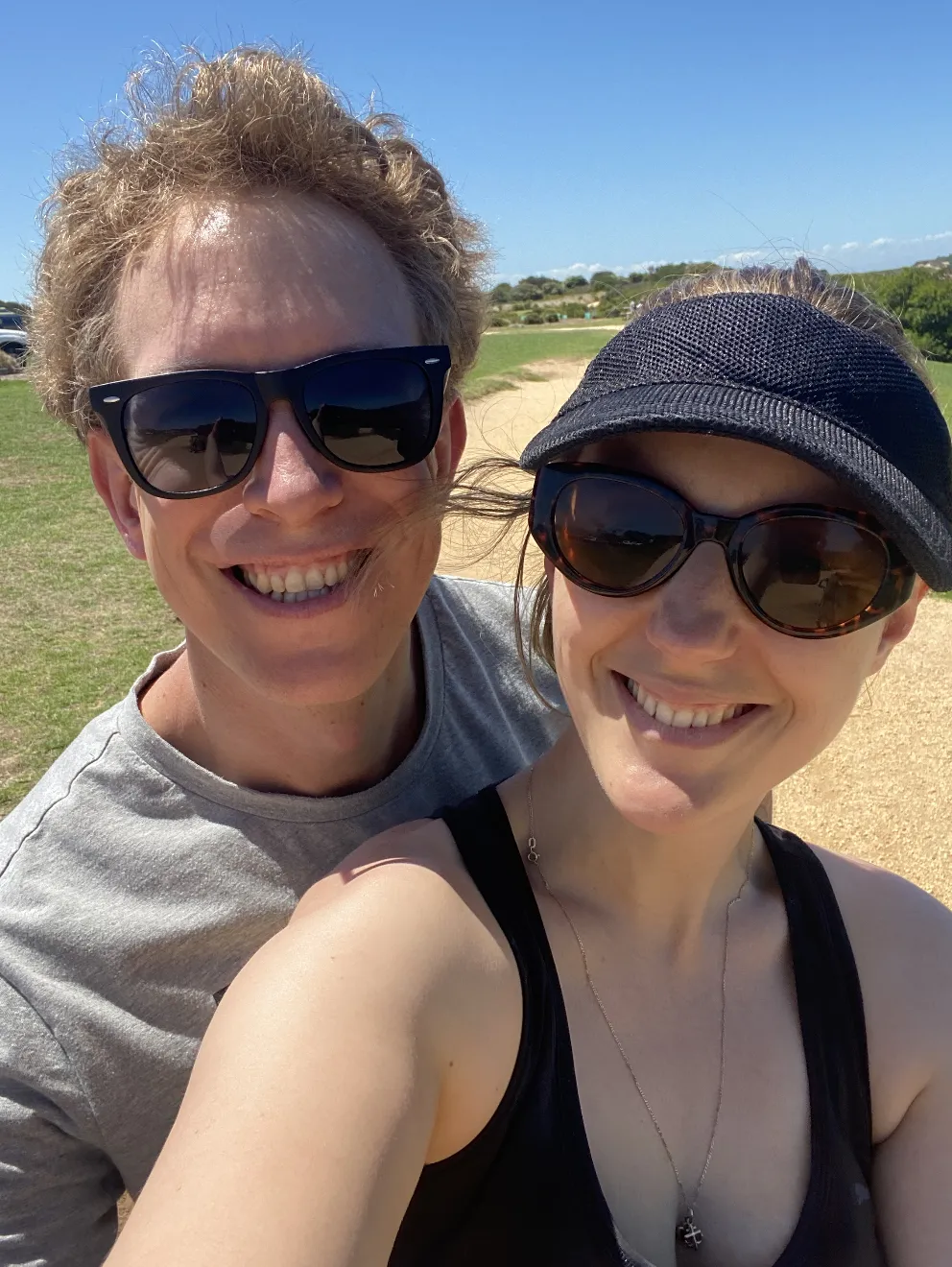
Hello! I’m Annelise.
I run this site alongside my wonderful husband Jason. We’re an Australian traveling homeschool family with 4 children (10, 8, 5, 2) who started our adventures in 2022.
Together, Jason and I run a marketing agency. I'm also a Business Coach for those looking to leverage their existing skills to create and grow profitable, freedom based businesses.
I started this site to support other travelling, homeschooling / entrepreneur families by sharing what we’re exploring and discovering along our homeschool / world school journey.
I definitely do not claim to have this whole thing figured out - it's the ultimate learning adventure for all of us!
If you're new here - this is the best place to start.
Tune into the World School Podcast, and Follow over on Instagram for more!
Copyright. All rights reserved. worldschool.blog

